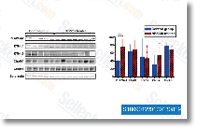This level of suppression didn’t have an impact on HSP27 or SPARC amounts, suggesting the total AKT inhi bition effects are downstream of SPARC and HSP27. Interestingly, the suppression of AKT1 2 had little impact on autophagic signaling or PARP cleavage selleck chemicals in spite of the unanticipated lessen in caspase 3 cleavage, This lack of death signaling was accompanied by increased colony forming efficiency, This result was equivalent to that observed when inhibiting SPARC, suggesting that AKT1 2 might mediate this element of SPARC regulation of survival.
That SPARC and AKT1 2 may function collectively in some as still unknown mechanism is rein forced by the observation that suppression of AKT1 2 also lowered SPARC induced death signaling in TMZ, Comparable signaling benefits were observed working with AKT3 siRNA, which was very effective at reducing AKT3 levels, While no adjustments were observed in colony forming efficiency GDC-0879 on account of inhibition of AKT3, suppression of SPARC induced death signaling in TMZ was also observed, These data recommend the AKTs contribute to SPARC induced sensitivity to TMZ, and confirms that this signaling has tiny result, as assessed by the clono genic assay, Inhibition of pAKT decreases SPARC and increases autophagy It was surprising that a reduction in complete AKTs didn’t affect the level of pAKT. We therefore taken care of LN443 cells with AKT inhibitor IV to especially assess the effects of pAKT inside the absence or presence of TMZ, These effects indicate that suppression of pAKT suppressed SPARC. The suppression of SPARC suggests that contrary to complete AKT, pAKT regulates SPARC expression in these cells. Inhibition of AKT action correlated with decreased caspase 3 cleavage, but elevated caspase 7 cleavage.
Though suppression of pAKT did not induce PARP cleavage following two days of therapy, the raise in cleaved caspase 7 by day 2 could contribute towards the slight delayed apoptosis observed by days four and six, As anticipated, the  inhibitor induced autophagy in these cells as indicated by decreased phospho and total PRAS40 by days four and six, the boost in LC3 II by day 2 and upkeep of higher LC3 II by days 4 and six with corresponding lower on p p62 and elevated p62 by days 4 and 6, The suppression of pAKT and induction of autophagy was accompanied by decreased survival in the absence or presence of TMZ, TMZ didn’t alter the signaling observed with AKT IV, Since the lowest dose of AKT inhibitor IV was sufficient to induce death of all cells while in the clono genic assay, the means of AKT inhibitor IV to sensitize cells to TMZ remedy was studied using reduce doses of each agents. Although growing AKT inhi bitor IV correlated with decreasing surviving fraction, AKT inhibitor IV didn’t more sensitize cells to TMZ, The information even more show that 0. 125 uM AKT inhibitor IV is extra productive than 80 uM TMZ, The combined data for your LN443 cells indicate that HSP27 regulates SPARC and pAKT in these cells, and its suppression is accompanied by decreased survival as a consequence of enhanced apoptosis and autophagy.
inhibitor induced autophagy in these cells as indicated by decreased phospho and total PRAS40 by days four and six, the boost in LC3 II by day 2 and upkeep of higher LC3 II by days 4 and six with corresponding lower on p p62 and elevated p62 by days 4 and 6, The suppression of pAKT and induction of autophagy was accompanied by decreased survival in the absence or presence of TMZ, TMZ didn’t alter the signaling observed with AKT IV, Since the lowest dose of AKT inhibitor IV was sufficient to induce death of all cells while in the clono genic assay, the means of AKT inhibitor IV to sensitize cells to TMZ remedy was studied using reduce doses of each agents. Although growing AKT inhi bitor IV correlated with decreasing surviving fraction, AKT inhibitor IV didn’t more sensitize cells to TMZ, The information even more show that 0. 125 uM AKT inhibitor IV is extra productive than 80 uM TMZ, The combined data for your LN443 cells indicate that HSP27 regulates SPARC and pAKT in these cells, and its suppression is accompanied by decreased survival as a consequence of enhanced apoptosis and autophagy.
Mirna Mimics
miRNA inhibitors for single or high throughput silencing
